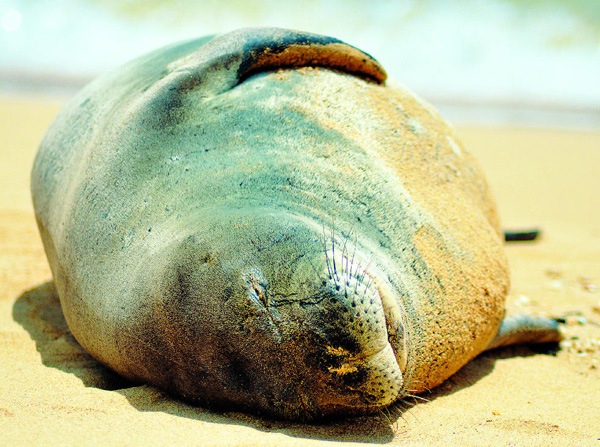LIHUE — A young female Hawaiian monk seal is recovering from having one eye surgically removed by veterinarians after being found in distress last month on Kauai’s North Shore. Jamie Thomton, the Kauai Marine Mammal response coordinator for the National
LIHUE — A young female Hawaiian monk seal is recovering from having one eye surgically removed by veterinarians after being found in distress last month on Kauai’s North Shore.
Jamie Thomton, the Kauai Marine Mammal response coordinator for the National Oceanic and Atmospheric Administration, said the injured seal was phoned in by a tourist Feb. 24 at Anini Beach.
“We got there and saw that she was thin and had the injury,” he said.
The 1- to 2-year-old seal, R1KU, was first reported by the Robinson family on Niihau, where federal officials gave her antibiotics for the damaged eye, according to David Schofield, a stranding coordinator for NOAA.
Less than a month later, the seal showed up at Anini, severely underweight and with signs of infection.
Serendipitously, the U.S. Coast Guard was conducting a training operation that day with one of its C-130 helicopters, and was able to fly the 95-pound animal to Oahu.
“It simulated a real rescue for them,” Schofield said. “It was really cool.”
The seal was taken to the Honolulu Zoo, where it underwent surgery Wednesday to remove the punctured eye.
“It’s not uncommon at all to see seals with one eye missing,” Schofield said. “It’s a rough world out there and there are big predators.”
It is unclear how the animal sustained the injury or when she might be healthy enough to be released back into the wild.
Just one day after surgery, Schofield said the seal was already showing signs of improvement, eating fish on her own from a small tray.
“We’re pretty confident that she’ll be all right out there (in the wild),” he said, adding she is already conditioned to swimming around and hunting for food with one eye.
Eventually, NOAA officials will begin feeding the seal live fish in her pool to simulate a natural environment.
Schofield said some people may question why NOAA would go through so much trouble for one animal.
“This is a female and you have an endangered population,” he said. “If we want to promote the recovery of the species, it’s really important to have young, sexually mature females.”
Schofield extended his thanks to the Robinson family for notifying NOAA and for their ongoing cooperation with the federal agency.
• Chris D’Angelo, environmental reporter, can be reached at 245-0441 or cdangelo@thegardenisland.com.


